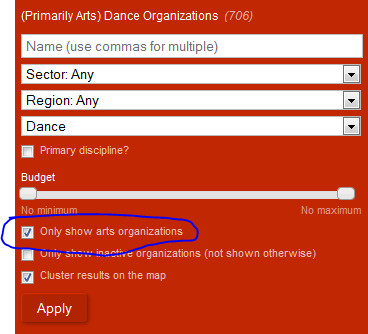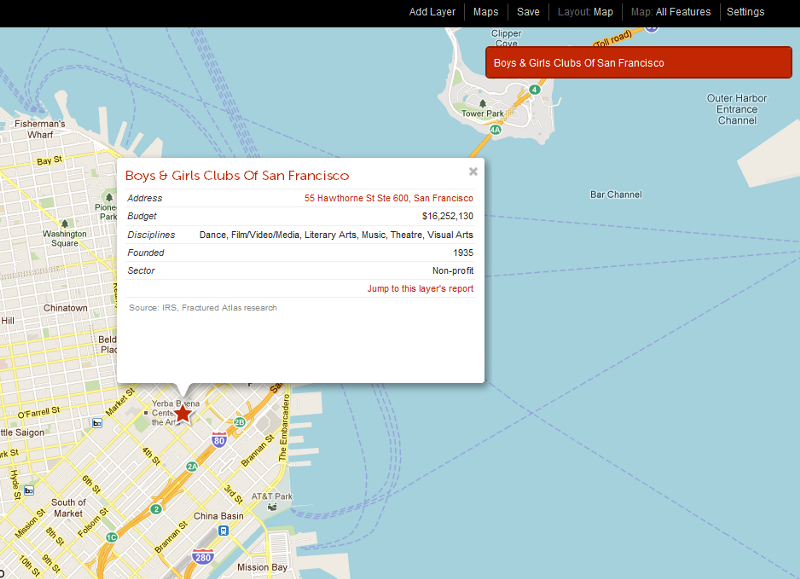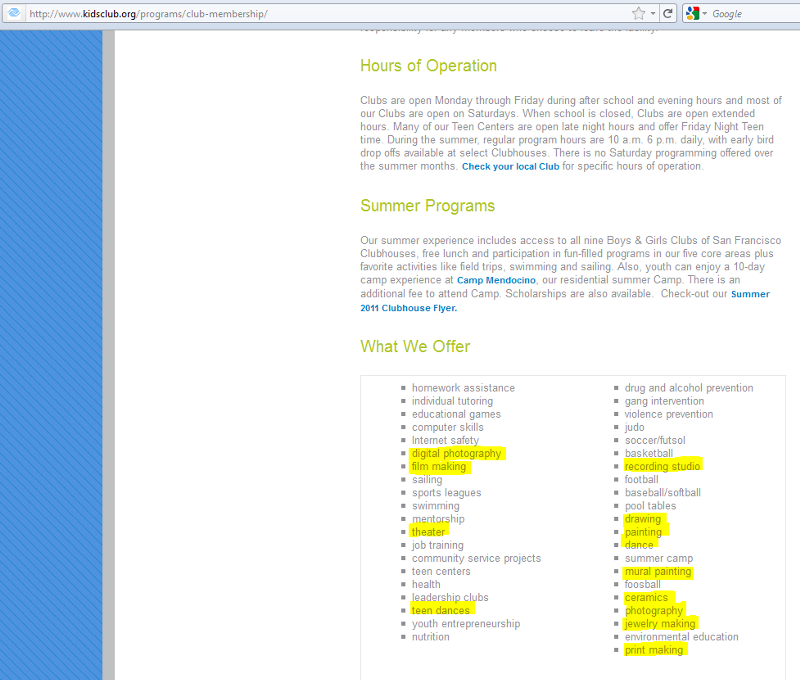By Ian David Moss on October 17th, 2011
An Ecosystem-Based Approach to Arts Research
(Part of an occasional series on Fractured Atlas’s research philosophy and practices. For more articles, click here.) As those of you who have been following Fractured Atlas closely may know, we’ve been working on some innovative technological solutions for aggregating and analyzing data about the cultural sector for the past couple of years. This effort is taking myriad forms at the moment, but probably the most comprehensive manifestation is our cultural asset mapping software, Archipelago. As originally designed for the William and Flora Hewlett Foundation in connection with the Bay Area Cultural Asset Map (BACAM), Archipelago seeks to shed light on the following questions about the cultural sector:
- Who’s making art?
- Who’s engaging with it?
- Where is it happening?
- How is it made possible?
This post will focus on how we’ve gone about addressing the first of these questions.
From the beginning, we’ve taken what we call an “ecosystem approach” to the question of identifying actors in the arts universe and the relationships between them. I’ve been thinking about arts ecosystems for a number of years now, ever since I sketched out my first interpretation of one while on the beach in the summer of 2008. Many renditions that I’ve seen since have featured in one fashion or another some key players: nonprofit arts organizations, funders, government, for-profits, artists, and audience members. Those elements are clearly important, but the reality is that the arts ecosystem is far more complicated.
It includes social service agencies, churches, and others that might provide arts programs. It includes not just for-profit firms that present arts programming directly, but also the companies that manufacture shoes for the ballet dancers, sell the strings for the guitars, and design the postcards for the show. It encompasses a huge range of patron roles from major donors and Board members, to passersby taking in a work of public art or ambient sound installation, to people who experience the arts only in their own homes. Arguably, it even includes Google, Facebook, Staples, and the IRS — entities with which almost every arts organization interacts, even if those entities are not arts-specific at all.
How do we make sense of such a vast collection of interrelated forces? The short answer is that we can’t — at least not yet with total accuracy and comprehensiveness. But with more and more types of data becoming available all the time, not just in the cultural sector but in every aspect of life, we can at least get a start. Archipelago represents an effort to draw as much of the ecosystem as possible together in one place so that it can be picked apart, analyzed, and put together again in all of its kaleidoscopic complexity. One of the classes of data we collect is everybody’s favorite, nonprofit arts organizations. Organizations are, in many ways, at the center of the data model created by Archipelago.
They carry with them information about their location, finances, and programming, publicly available through the IRS or for research purposes through the Cultural Data Project. They are connected with cultural facilities such as those available for rental through NYC Performing Arts Spaces or any of our other spaces databases around the country. They are the recipients, and sometimes the givers, of grants to support the arts. They have relationships with audience members, artists, and other organizations. Naturally, one of the first questions that arose during development was “what counts as an arts organization?” Organization data from the IRS comes with a set of codes to identify what an organization does. Using a system called NTEE (short for the National Taxonomy of Exempt Entities), the codes are designed to provide a detailed level of information about organizational activities. The easy thing to do, of course, would be to use the NTEE classifications provided with the IRS data to define which organizations count as arts-related — and indeed, this appears to be the default approach for most professional research conducted in the sector.
However, we soon realized that doing so would miss a lot of organizations that perhaps aren’t primarily arts organizations, but are still relevant to the arts ecosystem — such as universities, radio stations, foundations, even churches. (A recent report from the Irvine Foundation noted that, remarkably, more than a quarter of the organizations listed in the California Cultural Data Project were not represented among a broader list of nonprofits with arts-related NTEE codes.) We call organizations that touch the arts without primarily focusing on them “arts-relevant” to distinguish them from straight-up arts organizations. Through conversations with administrators and local arts council heads, we’ve heard a number of times that arts-relevant organizations play an indispensable role in local creative communities, particularly in more rural areas. An inspection of arts grants given out by the funders in our database reveals the same thing: social service agencies, community centers, environmental organizations and the like abound. Since we knew we wouldn’t really be able to answer the question “who’s making art?” if we didn’t include these arts-relevant organizations, it seemed important to work with as robust a data set as possible. Not only that, but we wanted Archipelago to be capable of adjusting how it responds depending on the nature of your query: did you want to know about just the organizations that we would consider “arts organizations,” or did you want to know about all of the organizations that touch the arts community, regardless of their primary focus?

To do this, we developed a set of algorithms and strategies to identify a large set of potential arts and arts-relevant organizations from the IRS data. Cross-checking each organization’s listing against its website, Form 990 information, calendar listings, and any other information we could find, we assigned our own categorizations to each organization, employing a three-level classification system as follows:
- Is it primarily an arts organization?
- In which discipline(s) does the organization have any relevance?
- With which discipline(s), if any, does the organization primarily identify?
After considering several classification systems, we elected to go with a very simple set of six disciplines: dance, film/video/media, literary arts, music, theater, and visual arts. This was a purposefully practical schema: these categorizations (or their equivalents) appear with remarkable consistency in actual field resources, such as our own Spaces database, Chicago Artist Resource and its offshoots, and many arts council and service organization websites. These six disciplines became the measuring stick for determining whether an organization whose focus was not primarily the arts belonged in our database. If an organization, no matter what it was, had some meaningful intersection with the world of music or film or any of the others, then by definition it deserved to be included. If an organization was interdisciplinary or multidisciplinary in nature, rather than assign it a vague “multidisciplinary” category, we simply marked each discipline in which it was relevant. Take the Boys & Girls Clubs of San Francisco, for example. I’m sure it’s hardly the first organization that comes to mind when you think of the arts community. And yet they are not only in the database, but they are in there marked with all six disciplines.

And why is that? It’s because they offer programming in each of those six disciplines. Check out their website, and you can see that, in fact, nearly a third of the activities they offer through their club network are arts-related!

While this approach was labor-intensive compared to just lifting the list directly from the IRS, it has afforded Archipelago tremendous analytical flexibility. If we want to perform statistical analysis just on arts organizations without having our numbers skewed by schools and YMCAs, we can limit our set just to primary arts organizations. But if we want to see the entire nonprofit dance ecosystem plotted out on a map, we won’t have limited ourselves to the usual suspects. It’s a whole new way of conceptualizing who belongs in the conversation about the arts, and it takes us one step closer to representing the full arts ecosystem in all of its diverse glory.

About Ian David Moss
Ian David Moss was the Senior Director of Information Strategy at Fractured Atlas, a nonprofit technology company that helps artists with the business aspects of their work. To learn more about Fractured Atlas, or to get involved, visit us here.

